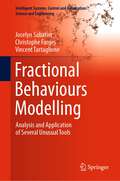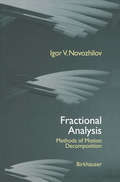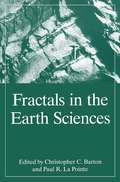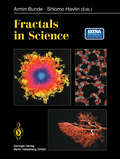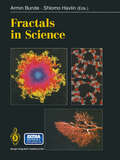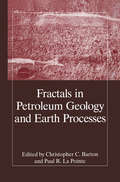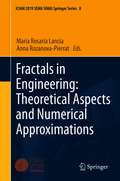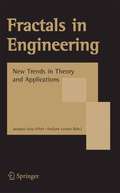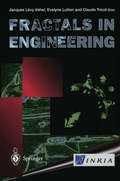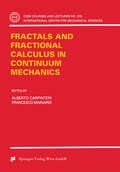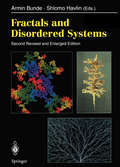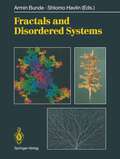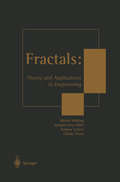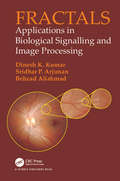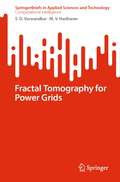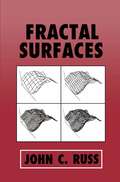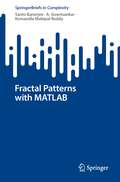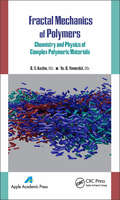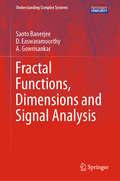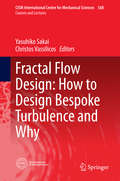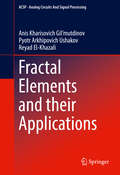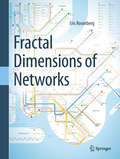- Table View
- List View
Fractional Calculus for Hydrology, Soil Science and Geomechanics: An Introduction to Applications
by Ninghu SuThis book is an unique integrated treatise, on the concepts of fractional calculus as models with applications in hydrology, soil science and geomechanics. The models are primarily fractional partial differential equations (fPDEs), and in limited cases, fractional differential equations (fDEs). It develops and applies relevant fPDEs and fDEs mainly to water flow and solute transport in porous media and overland, and in some cases, to concurrent flow and energy transfer. It is an integrated resource with theory and applications for those interested in hydrology, hydraulics and fluid mechanics. The self-contained book summaries the fundamentals for porous media and essential mathematics with extensive references supporting the development of the model and applications.
Fractional Calculus for Hydrology, Soil Science and Geomechanics: An Introduction to Applications
by Ninghu SuThis book is an unique integrated treatise, on the concepts of fractional calculus as models with applications in hydrology, soil science and geomechanics. The models are primarily fractional partial differential equations (fPDEs), and in limited cases, fractional differential equations (fDEs). It develops and applies relevant fPDEs and fDEs mainly to water flow and solute transport in porous media and overland, and in some cases, to concurrent flow and energy transfer. It is an integrated resource with theory and applications for those interested in hydrology, hydraulics and fluid mechanics. The self-contained book summaries the fundamentals for porous media and essential mathematics with extensive references supporting the development of the model and applications.
Fractional Behaviours Modelling: Analysis and Application of Several Unusual Tools (Intelligent Systems, Control and Automation: Science and Engineering #101)
by Jocelyn Sabatier Christophe Farges Vincent TartaglioneThis book is dedicated to the analysis and modelling of fractional behaviours that mainly result from physical stochastic phenomena (diffusion, adsorption or aggregation, etc.) of a population (ions, molecules, people, etc.) in a constrained environment and that can be found in numerous areas. It breaks with the usual approaches based on fractional models since it proposes to use unusual models which have the advantage of overcoming some of the limitations of fractional models. This book is dedicated to postgraduated students and to researchers in the field or those who wish to learn with a fresh perspective. After a review of fractional models and their limitations, it proposes and demonstrates the interest of four other modelling tools to capture fractional behaviours: new kernels in integral operators, Volterra equations, nonlinear models and partial differential equations with spatially variable coefficients. Several applications on real data and devices illustrate their efficiency.
Fractional Analysis: Methods of Motion Decomposition
by I.V. NovozhilovThis book considers methods of approximate analysis of mechanical, elec tromechanical, and other systems described by ordinary differential equa tions. Modern mathematical modeling of sophisticated mechanical systems consists of several stages: first, construction of a mechanical model, and then writing appropriate equations and their analytical or numerical ex amination. Usually, this procedure is repeated several times. Even if an initial model correctly reflects the main properties of a phenomenon, it de scribes, as a rule, many unnecessary details that make equations of motion too complicated. As experience and experimental data are accumulated, the researcher considers simpler models and simplifies the equations. Thus some terms are discarded, the order of the equations is lowered, and so on. This process requires time, experimentation, and the researcher's intu ition. A good example of such a semi-experimental way of simplifying is a gyroscopic precession equation. Formal mathematical proofs of its admis sibility appeared some several decades after its successful introduction in engineering calculations. Applied mathematics now has at its disposal many methods of approxi mate analysis of differential equations. Application of these methods could shorten and formalize the procedure of simplifying the equations and, thus, of constructing approximate motion models. Wide application of the methods into practice is hindered by the fol lowing. 1. Descriptions of various approximate methods are scattered over the mathematical literature. The researcher, as a rule, does not know what method is most suitable for a specific case. 2.
Fractals in the Earth Sciences
by C. C. Barton P. R. La PointeFractals have changed the way we understand and study nature. This change has been brought about mainly by the work of B. B. Mandelbrot and his book The Fractal Geometry of Nature. Now here is a book that collects articles treating fractals in the earth sciences. The themes chosen span, as is appropriate for a discourse on fractals, many orders of magnitude; including earthquakes, ocean floor topography, fractures, faults, mineral crystallinity, gold and silver deposition. There are also chapters on dynamical processes that are fractal, such as rivers, earthquakes, and a paper on self-organized criticality. Many of the chapters discuss how to estimate fractal dimensions, Hurst exponents, and other scaling exponents. This book, in a way, represents a snapshot of a field in which fractals has brought inspiration and a fresh look at familiar subjects. New ideas and attempts to quantify the world we see around us are found throughout. Many of these ideas will grow and inspire further work, others will be superseded by new observations and insights, most probably with future contributions by the authors of these chapters.
Fractals in Science
by Armin Bunde Shlomo HavlinA deeply detailed discussion of fractals in biology, heterogeneous chemistry, polymers, and the earth sciences. Beginning with a general introduction to fractal geometry it continues with eight chapters on self-organized criticality, rough surfaces and interfaces, random walks, chemical reactions, and fractals in chemisty, biology, and medicine. A special chapter entitled "Computer Exploration of Fractals, Chaos, and Cooperativity" presents computer demonstrations of fractal models: 14 programs are included on a 3 1/2" MS-DOS diskette which run on any PC with at least 1 MB RAM and a EGA or VGA graphics card, 16 colors.
Fractals in Science
by Armin Bunde Shlomo HavlinThe fractal concept has become an important tool for understanding irregular complex systems in various scientific disciplines. This book discusses in great detail fractals in biology, heterogeneous chemistry, polymers, and the earth sciences. Beginning with a general introduction to fractal geometry it continues with eight chapters on self-organized criticality, rough surfaces and interfaces, random walks, chemical reactions, and fractals in chemistry, biology, and medicine. A special chapter entitled "Computer Exploration of Fractals, Chaos, and Cooperativity" presents computer demonstrations of fractal models.
Fractals in Petroleum Geology and Earth Processes
by C. C. Barton P. R. La PointeIn this unique volume, renowned experts discuss the applications of fractals in petroleum research-offering an excellent introduction to the subject. Contributions cover a broad spectrum of applications from petroleum exploration to production. Papers also illustrate how fractal geometry can quantify the spatial heterogeneity of different aspects of geology and how this information can be used to improve exploration and production results.
Fractals in Engineering: Theoretical Aspects and Numerical Approximations (SEMA SIMAI Springer Series #8)
by Maria Rosaria Lancia Anna Rozanova-PierratFractal structures or geometries currently play a key role in all models for natural and industrial processes that exhibit the formation of rough surfaces and interfaces. Computer simulations, analytical theories and experiments have led to significant advances in modeling these phenomena across wild media. Many problems coming from engineering, physics or biology are characterized by both the presence of different temporal and spatial scales and the presence of contacts among different components through (irregular) interfaces that often connect media with different characteristics. This work is devoted to collecting new results on fractal applications in engineering from both theoretical and numerical perspectives. The book is addressed to researchers in the field.
Fractals in Engineering: From Theory to Industrial Applications
by Jacques Levy Vehel Evelyne Lutton Claude TricotFractal analysis research is expanding into a variety of engineering domains. The strong potential of this work is now beginning to be seen in important applications in real industrial situations. Recent research progress has already led to new developments in domains such as signal processing and chemical engineering, and the major advances in fractal theory that underlie such developments are detailed here. New domains of applications are also presented, among them environmental science and rough surface analysis. Sections include multifractal analysis, iterated function systems, random processes, network traffic analysis, fractals and waves, image compression, and applications in physics. Fractals in Engineering emphasizes the connection between fractal analysis research and applications to industry. It is an important volume that illustrates the scientific and industrial value of this exciting field.
Fractals and Fractional Calculus in Continuum Mechanics (CISM International Centre for Mechanical Sciences #378)
by Alberto Carpinteri Francesco MainardiThe book is characterized by the illustration of cases of fractal, self-similar and multi-scale structures taken from the mechanics of solid and porous materials, which have a technical interest. In addition, an accessible and self-consistent treatment of the mathematical technique of fractional calculus is provided, avoiding useless complications.
Fractals and Disordered Systems
by Armin Bunde Shlomo HavlinFractals and disordered systems have recently become the focus of intense interest in research. This book discusses in great detail the effects of disorder on mesoscopic scales (fractures, aggregates, colloids, surfaces and interfaces, glasses and polymers) and presents tools to describe them in mathematical language. A substantial part is devoted to the development of scaling theories based on fractal concepts. In ten chapters written by leading experts in the field, the reader is introduced to basic concepts and techniques in disordered systems and is led to the forefront of current research. This second edition has been substantially revised and updates the literature in this important field.
Fractals and Disordered Systems
by Armin Bunde Shlomo HavlinFractals and disordered systems have recently become the focus of intense interest in research. This book discusses in great detail the effects of disorder on mesoscopic scales (fractures, aggregates, colloids, surfaces and interfaces, glasses, and polymers) and presents tools to describe them in mathematical language. A substantial part is devoted to the development of scaling theories based on fractal concepts. In 10 chapters written by leading experts in the field, including E. Stanley and B. Mandelbrot, the reader is introduced to basic concepts and techniques in disordered systems and is lead to the forefront of current research. In each chapter the connection between theory and experiment is emphasized, and a special chapter entitled "Fractals and Experiments" presents experimental studies of fractal systems in the laboratory. The book is written pedagogically. It can be used as a textbook for graduate students, by university teachers to prepare courses and seminars, and by active scientists who want to become familiar with a fascinating new field.
Fractals: Theory and Applications in Engineering
by Michel Dekking Jacques Lévy-Véhel Evelyne Lutton Claude TricotOwing to the rapid emergence and growth of techniques in the engineering application of fractals, it has become necessary to gather the most recent advances on a regular basis. This book is a continuation of the first volume - published in 1997 - but contains interesting developments. A major point is that mathematics has become more and more involved in the definition and use of fractal models. It seems that the time of the qualitative observation of fractal phenomena has gone. Now the main models are strongly based upon theoretical arguments. Fractals: Theory and Applications in Engineering is a multidisciplinary book which should interest every scientist working in areas connected to fractals.
Fractals: Applications in Biological Signalling and Image Processing
by Dinesh Kumar Sridhar P. Arjunan Behzad AliahmadThe book provides an insight into the advantages and limitations of the use of fractals in biomedical data. It begins with a brief introduction to the concept of fractals and other associated measures and describes applications for biomedical signals and images. Properties of biological data in relations to fractals and entropy, and the association with health and ageing are also covered. The book provides a detailed description of new techniques on physiological signals and images based on the fractal and chaos theory. The aim of this book is to serve as a comprehensive guide for researchers and readers interested in biomedical signal and image processing and feature extraction for disease risk analyses and rehabilitation applications. While it provides the mathematical rigor for those readers interested in such details, it also describes the topic intuitively such that it is suitable for audience who are interested in applying the methods to healthcare and clinical applications. The book is the outcome of years of research by the authors and is comprehensive and includes other reported outcomes.
Fractals: Applications in Biological Signalling and Image Processing
by Dinesh Kumar Sridhar P. Arjunan Behzad AliahmadThe book provides an insight into the advantages and limitations of the use of fractals in biomedical data. It begins with a brief introduction to the concept of fractals and other associated measures and describes applications for biomedical signals and images. Properties of biological data in relations to fractals and entropy, and the association with health and ageing are also covered. The book provides a detailed description of new techniques on physiological signals and images based on the fractal and chaos theory. The aim of this book is to serve as a comprehensive guide for researchers and readers interested in biomedical signal and image processing and feature extraction for disease risk analyses and rehabilitation applications. While it provides the mathematical rigor for those readers interested in such details, it also describes the topic intuitively such that it is suitable for audience who are interested in applying the methods to healthcare and clinical applications. The book is the outcome of years of research by the authors and is comprehensive and includes other reported outcomes.
Fractal Tomography for Power Grids (SpringerBriefs in Applied Sciences and Technology)
by S. D. Varwandkar M. V. HariharanThe book introduces a new concept of Fractal Tomograph (FT) to study large and small perturbations of power grids. A mathematical phrase called Active Network Twins (ANT) is discovered which bears astonishing similarity with the human DNA. ANT forms the backbone of analysis. Lineflows and load voltages are compositions of ANT, called fractals which constitute tomographs. First three chapters discuss these new concepts. A remarkable feature is that a minute observation of tomograph is sufficient to detect a malaise in the past, present, or future of the grid. Editing like in genes, to control flows and voltages, is explained in chapter 4. The baffling loop flows in the US-Canada region, a metropolitan blackout in India, and outages in Nepal are illustrated with notional networks. Causes are crisply identified (chapters 5 and 6). Frequency rendezvous and blockchain approach to electricity costs (chapters 7, 8) are radically new perspectives. The book is useful for grid controllers and researchers.
Fractal Surfaces
by John C. RussThe author integrates discussions of fractal geometry, surface modeling techniques, and applications to real world problems to provide a comprehensive, accessible overview of the field. His work will equip researchers with the basic tools for measurement and interpretation of data, stimulating more work on these problems and, perhaps, leading to an understanding of the reasons that Nature has adopted this geometry to shape much of our world.
Fractal Patterns with MATLAB (SpringerBriefs in Complexity)
by Santo Banerjee A. Gowrisankar Komandla Mahipal ReddyThis book presents the iterative beauty of fractals and fractal functions graphically with the aid of MATLAB programming. The fractal images generated using the MATLAB codes provide visual delight and highly encourage the fractal lovers for creative thinking. The book compiles five cutting-edge research chapters, each with state-of-the art fractal illustrations. It starts with the fundamental theory for the construction of fractal sets via the deterministic iteration algorithm. Incorporating the theoretical base, fractal illustrations of elementary fractal sets are provided with the explicit MATLAB code. The book gives examples of MATLAB codes to present the fractal surfaces. This book is contributed to all the research beginners as well as the professionals on the field of fractal analysis. As it covers basic fractals like Sierpinski triangle to advanced fractal functions with explicit MATLAB code, the presented fractal illustrations hopefully benefit even the non-field readers. The book is a useful course to all the research beginners on the fractal and fractal-related fields.
Fractal Mechanics of Polymers: Chemistry and Physics of Complex Polymeric Materials
by G. V. Kozlov Yu G. YanovskiiThis new book explores the consideration of relationships that connect the structural and basic mechanical properties of polymeric mediums within the frameworks of fractal analysis with cluster model representations attraction. Incidentally, the choice of any structural model of medium or their combinations is defined by expediency and further usag
Fractal Functions, Dimensions and Signal Analysis (Understanding Complex Systems)
by Santo Banerjee D. Easwaramoorthy A. GowrisankarThis book introduces the fractal interpolation functions (FIFs) in approximation theory to the readers and the concerned researchers in advanced level. FIFs can be used to precisely reconstruct the naturally occurring functions when compared with the classical interpolants. The book focuses on the construction of fractals in metric space through various iterated function systems. It begins by providing the Mathematical background behind the fractal interpolation functions with its graphical representations and then introduces the fractional integral and fractional derivative on fractal functions in various scenarios. Further, the existence of the fractal interpolation function with the countable iterated function system is demonstrated by taking suitable monotone and bounded sequences. It also covers the dimension of fractal functions and investigates the relationship between the fractal dimension and the fractional order of fractal interpolation functions. Moreover, this book explores the idea of fractal interpolation in the reconstruction scheme of illustrative waveforms and discusses the problems of identification of the characterizing parameters. In the application section, this research compendium addresses the signal processing and its Mathematical methodologies. A wavelet-based denoising method for the recovery of electroencephalogram (EEG) signals contaminated by nonstationary noises is presented, and the author investigates the recognition of healthy, epileptic EEG and cardiac ECG signals using multifractal measures. This book is intended for professionals in the field of Mathematics, Physics and Computer Science, helping them broaden their understanding of fractal functions and dimensions, while also providing the illustrative experimental applications for researchers in biomedicine and neuroscience.
Fractal Flow Design: How to Design Bespoke Turbulence and Why (CISM International Centre for Mechanical Sciences #568)
by Yasuhiko Sakai Christos VassilicosThis book focuses on turbulent flows generated and/or influenced by multiscale/fractal structures. It consists of six chapters which demonstrate, each one in its own way, how such structures and objects can be used to design bespoke turbulence for particular applications and also how they can be used for fundamental studies of turbulent flows.
Fractal Elements and their Applications (Analog Circuits and Signal Processing)
by Anis Kharisovich Gil’mutdinov Pyotr Arkhipovich Ushakov Reyad El-KhazaliThis book describes a new type of passive electronic components, called fractal elements, from a theoretical and practical point of view. The authors discuss in detail the physical implementation and design of fractal devices for application in fractional-order signal processing and systems. The concepts of fractals and fractal signals are explained, as well as the fundamentals of fractional calculus. Several implementations of fractional impedances are discussed, along with comparison of their performance characteristics. Details of design, schematics, fundamental techniques and implementation of RC-based fractal elements are provided.
Fractal Dimensions of Networks (Springerbriefs In Computer Science Ser.)
by Eric RosenbergCurrent interest in fractal dimensions of networks is the result of more than a century of previous research on dimensions. Fractal Dimensions of Networks ties the theory and methods for computing fractal dimensions of networks to the “classic” theory of dimensions of geometric objects.The goal of the book is to provide a unified treatment of fractal dimensions of sets and networks. Since almost all of the major concepts in fractal dimensions originated in the study of sets, the book achieves this goal by first clearly presenting, with an abundance of examples and illustrations, the theory and algorithms for sets, and then showing how the theory and algorithms have been applied to networks. Thus, the book presents the classical theory and algorithms for the box counting dimension for sets, and then presents the box counting dimension for networks. All the major fractal dimensions are studied, e.g., the correlation dimension, the information dimension, the Hausdorff dimension, the multifractal spectrum, as well as many lesser known dimensions. Algorithm descriptions are accompanied by worked examples, many applications of the methods are presented, and many exercises, ranging in difficulty from easy to research level, are included.
